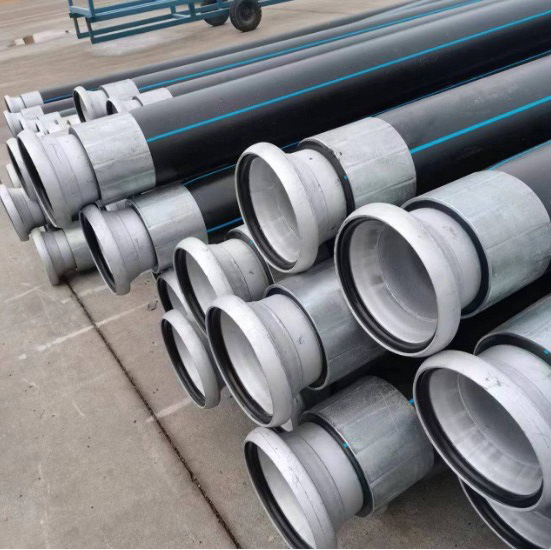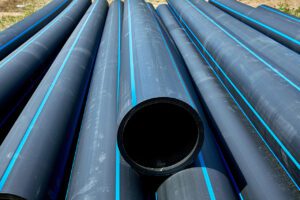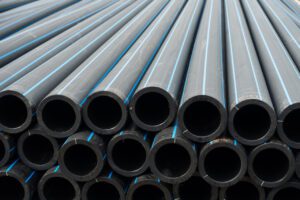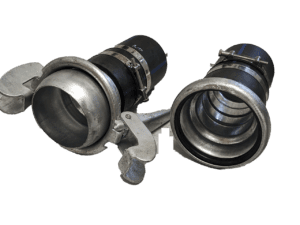Engineered for reliability and quick connect/disconnect properties, Anaconda
HDPE Pipe caters to diverse applications with precision and durability.
Home
HDPE Pipe Solutions
Bauer Fittings:
All Anaconda HDPE pipe is fitted with Bauer couplings, the most flexible, modular, and cost-effective fittings available today.
With Bauer fittings, the pipe can be easily disconnected, replaced, and reconnected at a fraction of the time and labor cost of virtually any other fitting or HDPE pipe coupler today available.
Read more about Bauer fittings here.
Rent Or Sale: Anaconda Pipe & Hose is one of the only HDPE industrial pipe manufacturers in North America to offer customers the ability to rent HDPE pipe (certain limitations apply, please inquire for details) as well as own. Cut your project’s cost basis by considering a short term HDPE pipe rental.
Customizable: Anaconda Pipe and Hose provides a broad array of HDPE pipe customization options, allowing clients to choose the suitable diameter, length, and material composition for their specific industrial applications.
Multiple Applications: Suitable for diverse applications, including fluid transport, chemical processing, and industrial fluid systems. Anaconda HDPE pipes offer versatility across a spectrum of industrial settings.
Compatible Fittings: Designed to seamlessly connect with various fittings, ensuring a secure and leak-free joint, whether using threaded connections, Bauer fittings, ANSI flanges, or couplings.

Discover Superior Quality
See how Anaconda Pipe & Hose’s DR11, DR17 and DR26 pipes with quick connecting Bauer fittings can improve your project. Find the perfect fit for your application!
HDPE DR11 Pipe
Size | Length | Outer Diameter | Inner Diameter | Thickness | Minimum Quantity | Get Pricing |
|---|---|---|---|---|---|---|
3" (75 mm) | 36' (11 m) | 2.95" (75mm) | 2.41" (61.2mm) | 0.268" (6.8mm) | 25 | |
4” (110 mm) | 36' (11 m) | 4.33" (125.0mm) | 3.54" (89.9mm) | 0.394" (10.0mm) | 25 | |
5” (125 mm) | 36' (11 m) | 4.92" (145.0mm) | 4.02" (102.1mm) | 0.449" (11.4mm) | 25 | |
6" (160 mm) | 36' (11 m) | 6.3" (160.0mm) | 5.15" (130.8mm) | 0.575" (14.6mm) | 1 | |
8” (225 mm) | 36' (11 m) | 8.86" (225.0mm) | 7.25" (184.2mm) | 0.807" (20.5mm) | 1 | |
10” (280 mm) | 36' (11 m) | 11.02" (280.0mm) | 9.02" (229.1mm) | 1.000" (25.4mm) | 25 | |
12” (315 mm) | 36' (11 m) | 12.4" (315.0mm) | 10.15" (257.8mm) | 1.126" (28.6mm) | 25 | |
14” (355 mm) | 36' (11 m) | 13.98" (355.0mm) | 11.44" (290.6mm) | 1.268" (32.2mm) | 25 |
HDPE DR17 Pipe
Size | Length | Outer Diameter | Inner Diameter | Thickness | Minimum Quantity | Get Pricing |
|---|---|---|---|---|---|---|
3" (75 mm) | 36' (11 m) | 2.95" (75.0mm) | 2.60" (66.0mm) | 0.177" (4.5mm) | 25 | |
4” (110 mm) | 36' (11 m) | 4.33" (110.0mm) | 3.81" (110.2mm) | 0.26" (6.6mm) | 25 | |
5” (125 mm) | 36' (11 m) | 4.92" (125.0mm) | 4.34" (128.5mm) | 0.291" (7.4mm) | 25 | |
6" (160 mm) | 36' (11 m) | 6.3" (160mm) | 5.55" (141.0mm) | 0.374" (9.5mm) | 25 | |
8” (225 mm) | 36' (11 m) | 8.86" (225.0mm) | 7.80" (198.1mm) | 0.528" (13.4mm) | 25 | |
10” (280 mm) | 36' (11 m) | 11.02" (279.9mm) | 9.71" (246.6mm) | 0.654" (16.6mm) | 25 | |
12” (315 mm) | 36' (11 m) | 12.4" (315.0mm) | 10.93" (277.6mm) | 0.736" (18.7mm) | 25 | |
14” (355 mm) | 36' (11 m) | 14" (355.0mm) | 12.32" (312.9mm) | 0.831" (21.1mm) | 25 |
Discover the Benefits of Renting HDPE Pipe
If your project is short-term, nothing beats the pricing and convenience of
renting HDPE pipe with Bauer fittings. Contact us now to get started.
Anaconda Industrial Pipe Benefits
Anaconda Pipe & Hose delivers state-of-the-art industrial HDPE pipe solutions engineered to meet the rigorous demands of diverse applications. Our industrial pipes stand out with the following technical features:
1. Bauer Fittings For Easy Connection/Disconnection
Modularity: The use of Bauer fittings provides a quick and easy connection and disconnection of HDPE pipes, allowing for the creation of modular and versatile pipeline systems. This modularity facilitates rapid deployment and adaptation to changing dredging requirements.
2. Materials and Construction
 Precision Craftsmanship: Anaconda industrial HDPE pipes are crafted from high-quality materials, ensuring durability and longevity in challenging industrial environments.
Precision Craftsmanship: Anaconda industrial HDPE pipes are crafted from high-quality materials, ensuring durability and longevity in challenging industrial environments.
3. Pressure and Temperature Ratings
High-Pressure Capability: Designed to handle varying pressure levels, our pipe ensures reliable fluid conveyance even under high-pressure conditions.
Temperature Resilience: These HDPE pipes are engineered to withstand a broad temperature range, making them suitable for applications in extreme climate conditions.
4. Corrosion Resistance
Protective Coatings: Anaconda HDPE pipe is extremely resistant to corrosion, extending the lifespan and maintaining optimal performance in corrosive environments.
5. Dimensional Accuracy
Precision Dimensions: Manufactured with precise measurements to ensure seamless integration with fittings and equipment, minimizing the risk of leaks or inefficiencies.
6. Flexibility and Rigidity
Flexibility Options: Depending on the application, Anaconda HDPE pipes offer a range of flexibility, allowing adaptation to various installation configurations.
Structural Integrity: While flexible, these pipes maintain structural integrity to prevent collapse or deformation during operation.
7. Quality Assurance
Stringent Testing: Anaconda industrial pipes undergo rigorous quality control and testing procedures, ensuring compliance with industry standards and optimal performance.
Anaconda Pipe & Hose takes pride in delivering industrial HDPE pipes that prioritize durability, performance, and versatility. Our commitment to excellence ensures that Anaconda HDPE pipe meets the demanding requirements of modern industrial processes, providing reliable solutions for a wide range of applications.
Industries Utilizing Anaconda Industrial HDPE Pipe
 Industrial HDPE pipe is critical in various industries, offering versatile solutions for fluid transport, material conveyance, and structural applications. Here’s a technical description of the primary industries where industrial HDPE pipe can find extensive use:
Industrial HDPE pipe is critical in various industries, offering versatile solutions for fluid transport, material conveyance, and structural applications. Here’s a technical description of the primary industries where industrial HDPE pipe can find extensive use:
Application: Transmission of crude oil, natural gas, and other hydrocarbons.
Industrial HDPE pipe in the oil and gas sector withstands high-pressure environments, corrosion-resistant coatings, and stringent material specifications to ensure the safe and efficient transportation of fossil fuels.
Application: Conveyance of chemicals, acids, and corrosive substances.
Industrial pipes in chemical processing are engineered with materials resistant to chemical corrosion, ensuring their integrity and preventing contamination during fluid transfer.
Application: Material transport within manufacturing plants and industrial processes.
HDPE pipe for manufacturing offers precise dimensions, varying flexibility, and compatibility with different materials, facilitating efficient and controlled material flow in diverse production settings.
Application: Distribution of clean water and conveyance of wastewater.
Industrial HDPE pipes for water and wastewater feature materials resistant to corrosion and contaminants. They comply with stringent standards to ensure the safe and reliable transport of water in municipal and industrial water systems.
Application: Structural support, water supply, and material transport on construction sites.
Industrial pipes offer key structural integrity and durability benefits in construction. They may be used for scaffolding, underground utilities, or conduits for various construction materials.
Application: Transport of ores, minerals, and slurry in mining operations.
Industrial pipes in mining are designed to handle abrasive materials, high pressures, and challenging terrain. Their abrasion-resistant coatings and robust construction ensure longevity in demanding mining environments.
Application: Transport of fluids in power plants, including steam and cooling water.
Industrial HDPE pipes in power generation can endure high temperatures and pressures. They are often designed with materials suitable for steam transport and offer corrosion-resistant coatings for longevity.
Application: Conveyance of water for irrigation, fertilizers, and pesticides.
Agricultural industrial pipes must be flexible, durable, and resistant to UV exposure. They are utilized in irrigation systems, ensuring efficient water distribution in agricultural fields.
- Food and Beverage Industry
Application: Transport of liquids in food and beverage processing plants.
Industrial HDPE pipes in the food industry are made from materials compliant with food-grade standards. They prevent contamination and maintain the hygienic standards required in food processing.
Application: In automotive and aerospace manufacturing, industrial pipes require precision and resistance to hydraulic fluids and coolants. They play a crucial role in maintaining the efficiency of manufacturing systems.
Industrial HDPE pipe is indispensable in numerous industries, each demanding specific technical characteristics to meet the challenges of their respective applications. Whether conveying fluids, supporting structures, or facilitating manufacturing processes, HDPE pipe contributes significantly to the seamless and efficient operation of diverse industrial sectors.
Level Up Your Project
Need a tailored industrial pipe solution? Our experts are ready to customize pipes to meet your specific requirements.
Industrial Pipe Fittings
Bauer Fittings

Bauer fittings stand out as versatile and reliable components in any kind of industrial pipe system (including wastewater and irrigation), offering a range of technical advantages that contribute to efficient fluid handling and ease of use. These fittings, also known as “Bauer Couplings,” are well established because of their quick and secure connection capabilities, providing numerous benefits for various industries. Here’s a detailed look at the technical advantages of Bauer fittings (also known as Bauer Couplers) particularly when it comes to HDPE pipes:
1. Rapid and Secure Connection
Bauer fittings are designed for quick and efficient coupling. Their innovative design allows for rapid connection and disconnection, significantly reducing downtime during pipe assembly or disassembly. The secure connection ensures leak-free operations, promoting system reliability and environmental safety.
2. Versatile Applications
Bauer fittings find application across diverse industries, including agriculture, construction, dredging, mining, and more. Their versatility stems from the ability to connect pipes of various materials and sizes, providing a standardized and adaptable solution for different fluid transport needs.
3. Durable and Robust Construction
Bauer fittings are constructed from robust materials, often high-quality galvanized steel, ensuring durability and resistance to corrosion. This robust construction allows the fittings to withstand the rigors of even the most difficult industrial environments, providing a long service life and minimizing the need for frequent replacements.
4. Sealing Mechanism
Bauer fittings incorporate a reliable outer diameter sealing mechanism for high-density polyethylene pipes, ensuring a tight, leak-proof connection. EPDM or NBR gaskets enhance the sealing properties, making the fittings suitable for a wide range of fluids, including water, chemicals, and slurry.
5. Pressure Ratings
Bauer fittings are engineered to handle varying pressure requirements. The fittings are available in different pressure classes, allowing users to select the appropriate fittings based on the specific demands of their applications. This flexibility ensures compatibility with a broad range of industrial systems.
6. Ease of Handling and Operation
The design of Bauer fittings incorporates user-friendly features, making them easy to handle and operate. The quick-locking mechanism simplifies the connection process, enabling operators to manage pipe systems with minimal effort efficiently.
7. Interchangeability
One notable technical advantage of Bauer fittings is their interchangeability. Fittings of the same size and type from different manufacturers can often be used interchangeably and even with varying pipe materials. This interchangeability enhances flexibility in sourcing components and simplifies maintenance and repairs because there is no need for additional pipe fusing or welding.
8. Reduced Maintenance Requirements
Bauer fittings’ durability and robustness contribute to reduced maintenance needs. Their resistance to corrosion and wear minimizes the risk of component failure, resulting in lower maintenance costs and increased operational efficiency of HDPE piping.
9. Cost-Effective Solutions
Bauer fittings offer easily the most cost-effective HDPE pipe connection solutions for fluid handling applications. The ease of installation, interchangeability, and durability massively contribute to overall labor cost savings, making them an economical choice for companies seeking reliable and efficient diameter pipe connections.
10. Safety & User Friendly
Bauer fittings are designed with user safety in mind. The assembly process is straightforward, reducing the risk of accidents or injuries during pipeline connections and disconnections.
11. Wide Range of Accessories
Bauer fittings come with various complementary accessories, such as caps, plugs, and reducers. These accessories enhance the versatility of the fittings, allowing users to customize and optimize their diameter pipe systems according to their specific requirements.
Bauer fittings provide a robust and versatile solution for industrial pipe systems. Their technical benefits, including rapid connection, durability, and versatility, make them a preferred choice for industries where efficient fluid handling with HDPE piping is paramount.
ANSI Flange Fittings
ANSI flange fittings are integral components in Anaconda HDPE pipe systems, and they are renowned for their standardized design and versatile applications. These fittings adhere to the American National Standards Institute (ANSI) specifications, providing a range of technical advantages for fluid handling in various industries. Here’s a detailed examination of the technical benefits of ANSI flange fittings:
1. Standardized Design
ANSI flange fittings follow standardized dimensions and specifications, ensuring uniformity across manufacturers. This standardization allows for the interchangeability of ANSI flanges and fittings, simplifying procurement and maintenance processes.
2. Ease of Installation
The design of ANSI flange fittings facilitates easy installation and removal. The bolt-hole patterns and flange faces adhere to ANSI standards, enabling quick alignment and connection. This ease of installation reduces labor costs and downtime during pipe assembly or modifications.
3. Wide Range of Applications
ANSI flange fittings have diverse industrial applications, including oil and gas, fisheries, chemical processing, and more. Their standardized design allows for compatibility with various pipe and hose materials and fluids, making them suitable for various applications.
4. Durable and Corrosion-Resistant Construction
ANSI flange fittings are commonly constructed from carbon steel, stainless steel, alloy steel, or other materials. This robust construction ensures durability and corrosion resistance, especially if used for potable water. These systems have also shown themselves to be ultra strong, with one major natural gas installation standing up to intensive seismic activity in British Columbia. It also enhances the longevity of the fittings for HDPE systems, making them suitable for harsh industrial environments.
5. Pressure and Temperature Ratings
ANSI flange fittings are engineered to meet specific pressure and temperature ratings, allowing for safe and reliable performance of HDPE systems in various operating conditions. These fittings are available in different classes, providing flexibility for users to select fittings based on their specific system requirements.
6. Sealing Mechanism
ANSI flange fittings incorporate a gasket sealing mechanism for HDPE systems. The use of materials like compressed rubber, or PTFE ensures a reliable and leak-free seal between mating flanges. The sealing mechanism contributes to the integrity of the pipe system, preventing fluid leaks.
7. Versatility in Flange Types
ANSI standards encompass various flange types, such as slip-on, weld neck, blind, and lap joint flanges. This versatility allows users to choose the appropriate flange type based on their specific application and system requirements, enhancing flexibility in design.
8. Facilitates Piping System Maintenance
The standardized design of ANSI flange fittings simplifies maintenance and repairs. The ease of disassembly and reassembly with ANSI flanges enables quick access to components, reducing downtime during maintenance activities and minimizing disruption to industrial processes.
9. Compliance with Industry Standards
ANSI flange fittings adhere to industry standards, ensuring compliance with safety and quality requirements.
10. Facilitates System Expansion
The standardized nature of ANSI flange fittings allows for straightforward HDPE pipe system expansion or modification. Anaconda pipes with ANSI fittings do tend to include a rotatable ANSI flange on one end of the hose or pipe, adding to overall installation ease. Additional components can be easily integrated into existing piping systems, contributing to the adaptability and scalability of industrial installations.
Opting for Straight Lengths Without Fittings
While standard industrial practice involves incorporating fittings into HDPE pipe and hose applications for various purposes, there may be specific scenarios where opting for straight lengths without fittings can have certain benefits. It’s essential to understand the technical considerations and potential advantages of such a choice:
1. Reduced Friction and Flow Resistance
Straight HDPE pipe lengths, without including fittings, can offer a smoother and more streamlined fluid flow path. The absence of abrupt changes in direction minimizes frictional resistance and turbulence, potentially enhancing overall flow efficiency.
2. Simplified Maintenance
Straight lengths of HDPE pipe can, in some instances, simplify maintenance procedures. Without fittings, fewer components are prone to wear or potential failure points. This could reduce the frequency and complexity of maintenance activities, contributing to a more straightforward and cost-effective maintenance regime on a very long term basis.
3. Custom Length Configurations
Opting for straight lengths allows for custom configurations tailored to specific project requirements. While standard HDPE pipe lengths are common, the ability to customize lengths without additional fittings can be advantageous for achieving precise dimensions in a piping system.
4. Minimized Risk of Leakage
HDPE pipe fittings are potential points of vulnerability for leaks. Minimizing the number of fittings can reduce the overall risk of leakage in the system. This is particularly relevant in applications where leak prevention is critical, such as in systems handling hazardous materials.
5. Streamlined Installation
The absence of HDPE fittings simplifies the installation process. Straight lengths can be easier to handle and align during installation, potentially reducing labor costs and installation time. This streamlined process could be advantageous in large-scale projects with extensive piping networks.
6. Enhanced Structural Integrity
Straight lengths contribute to a more continuous and uniform structure. This can enhance the overall structural integrity of the piping system, particularly in applications where stability and resistance to external forces are crucial considerations.
7. Optimized Flow Dynamics
A piping system composed of straight lengths can offer optimized flow dynamics. The absence of fittings-related disruptions allows for a more predictable and controlled flow pattern, which can be important in applications requiring precise fluid dynamics.
8. Cost Savings in Some Cases
Depending on the project requirements, material costs, and installation considerations, opting for straight lengths without fittings may result in cost savings. This is especially true when the specific design and application allow for a simplified configuration.
9. Specialized Applications
In specific specialized applications where fittings are not required due to the nature of the fluid, pressure requirements, or system design, straight lengths without fittings can be a technically viable option.
10. Adherence to Project Specifications
This configuration ensures compliance with design requirements and specifications in scenarios where project specifications explicitly call for straight diameters without fittings.
It’s crucial to note that the decision to use HDPE pipe straight lengths without fittings should be made based on a thorough understanding of the specific project requirements, industry standards, and regulatory considerations. While there can be potential benefits, the choice must align with the technical and safety requirements of the industrial application. In our experience, HDPE pipes with no fittings can create connection and disconnection difficulties and delays that are eliminated by Bauer or ANSI fittings. Consulting with engineers and adhering to industry best practices is essential in making informed decisions regarding piping configurations.
Frequently Asked Questions
Welcome to our Industrial HDPE Pipe FAQ section. Here, we address common queries about our high-quality industrial pipes designed for various applications. If you have additional questions, always feel free to contact our experts for personalized assistance.
What industries are HDPE pipes suitable for?
Answer: Our HDPE pipes cater to a broad spectrum of industries, including but not limited to agriculture, construction, mining, oil & gas, power generation, and dredging. Each piece of Anaconda HDPE pipe is engineered to meet the specific demands of its intended application and comes with Bauer fittings pre-fused to ensure quick connection and disconnection.
What types of industrial pipes does Anaconda Pipe and Hose offer?
Answer: Anaconda Pipe and Hose specializes exclusively in HDPE Pipe, with fast-connect fittings (Bauer Fittings) that perform spectacularly in applications where installations require quick connection and disconnection. We also offer a variety of heavy-duty industrial hoses, including not only specialty slurry discharge and suction hose, but also a wide variety of lay flat hoses.
What joining methods are recommended for HDPE pipe?
Answer: Anaconda recommends Bauer Fittings for joining HDPE pipe lengths. These fittings offer incredible value in real-world applications because they require no specialized tools to disconnect or reconnect. For our slurry hoses, we recommend ANSI Flange connections – for additional ease of use, all of our hoses come with rotation-friendly flanges on one end. This method ensures secure and leak-resistant connections, and enables efficient usage in real-world conditions while contributing to overall system safety.
Are industrial HDPE pipes suitable for high-pressure applications?
Answer: Yes, Anaconda’s industrial HDPE pipe is engineered to handle high-pressure conditions. Our hose and pipe are designed to ensure safety and reliability, whether for hydraulic systems, slurry transport, or other high-pressure applications.
Can Anaconda provide customized HDPE pipe?
Answer: Anaconda Pipe & Hose offers customization services, but only on large orders. While we understand that different applications have unique requirements, most of our HDPE pipes come in standard 36-foot lengths and are equipped with Bauer Fittings for efficient use and re-use. In special cases, our team works closely with clients to tailor industrial pipes in terms of length, dimensions, and specifications to meet specific application needs.
How can I get technical assistance or order Anaconda’s industrial HDPE pipes?
Answer: Please contact our dedicated team for technical assistance or to place an order. We’re here to assist you with HDPE pipe sizes and dimensions, product selection, customization, and any other inquiries.
Is it possible to rent HDPE pipe and/or heavy duty slurry hose from Anaconda?
Answer: Anaconda can arrange for customers to rent HDPE pipes, slurry hoses, pumps, and other critical equipment. Simply contact us here to discuss this useful option.
What is the expected lifespan of Anaconda HDPE pipes?
Answer: Anaconda HDPE pipes are designed for durability and long-term use, often lasting 50 years or more under normal operating conditions. Factors like application, exposure to UV, and pressure levels can influence the lifespan, but our HDPE pipes are manufactured to withstand rigorous industrial demands.
Are Anaconda HDPE pipes resistant to chemical corrosion?
Answer: Yes, HDPE pipes from Anaconda are highly resistant to a variety of chemicals, making them suitable for industries that involve corrosive substances, such as mining and agriculture. Our pipes offer a reliable solution for transporting aggressive materials and maintaining system integrity.
What temperature ranges can Anaconda HDPE pipes withstand?
Answer: Anaconda HDPE pipes perform reliably in temperatures ranging from -40°F to 140°F (-40°C to 60°C). For applications involving extreme temperatures, we recommend consulting our technical team to ensure the pipes meet the specific requirements.
Does Anaconda offer on-site support for HDPE pipe installation?
Answer: Yes, we offer on-site support services to assist with HDPE pipe installation and setup. Our experienced team guides installation techniques, connection methods, and system configuration to ensure optimal performance and safety. Contact us to arrange for on-site assistance.
Get Started Today.
Anaconda Pipe & Hose solutions are built to your specifications, ensuring the best fit and finish.
Our experts are ready to help you succeed!

